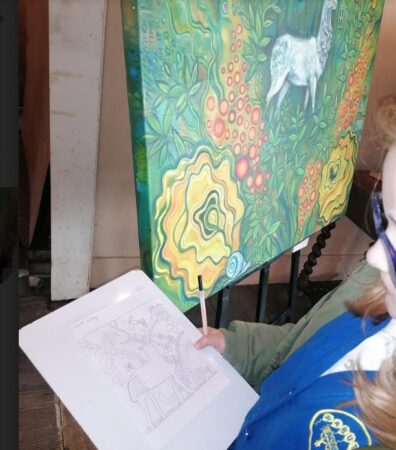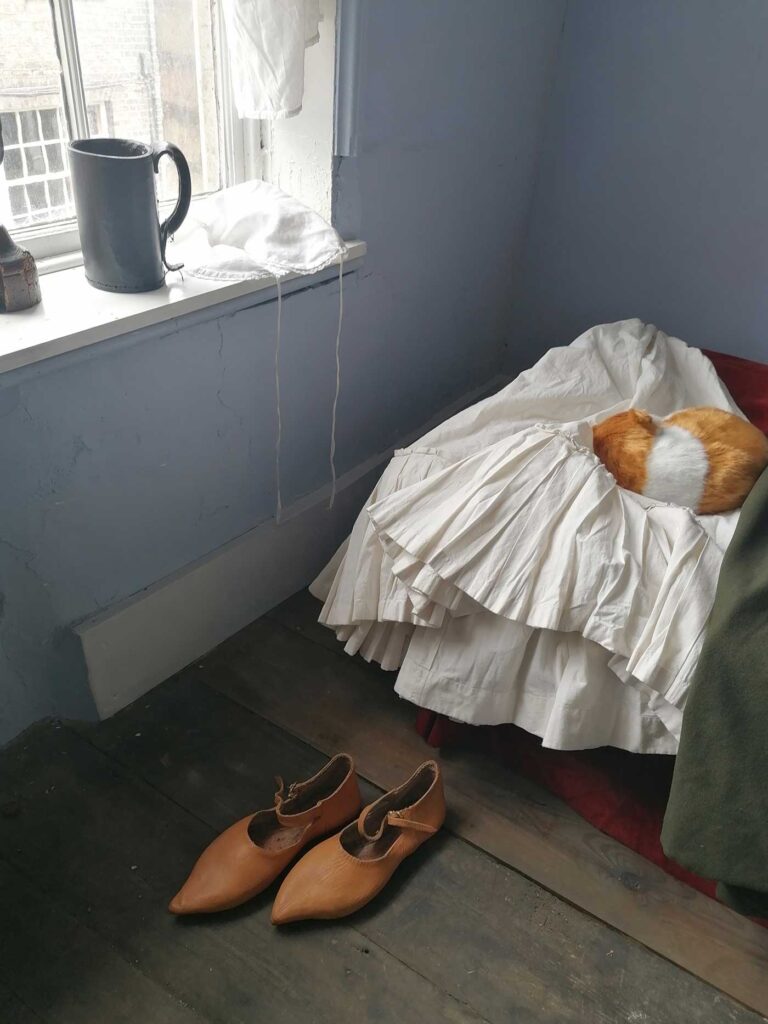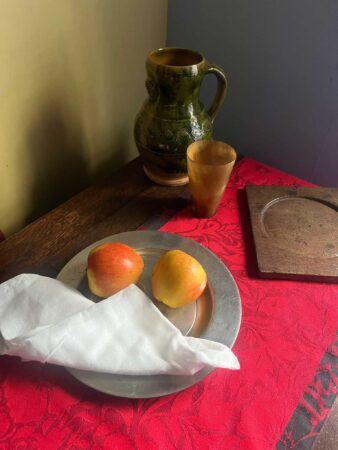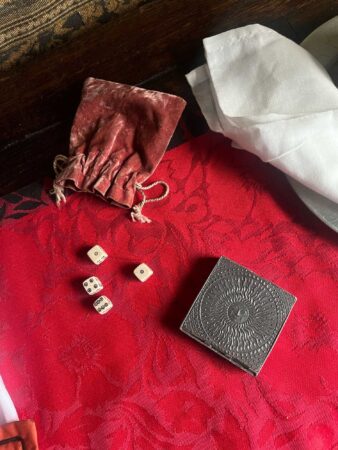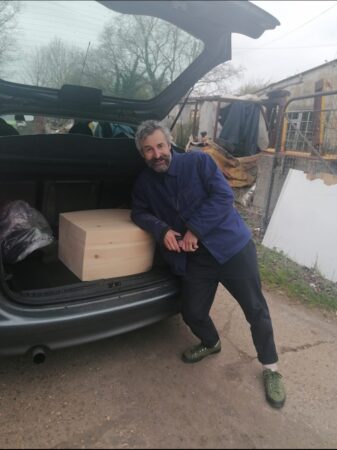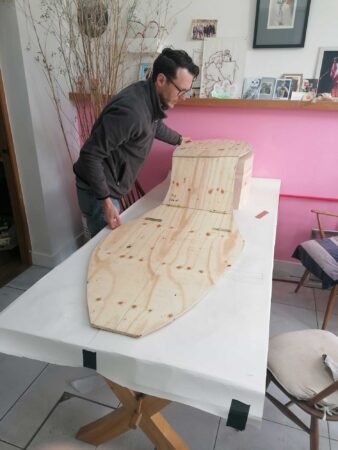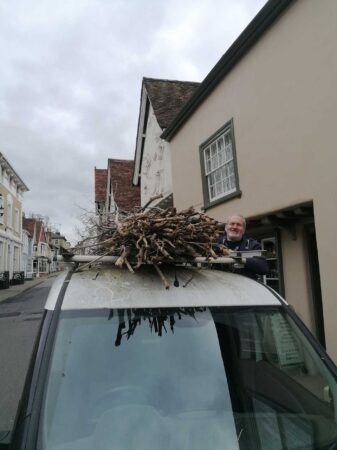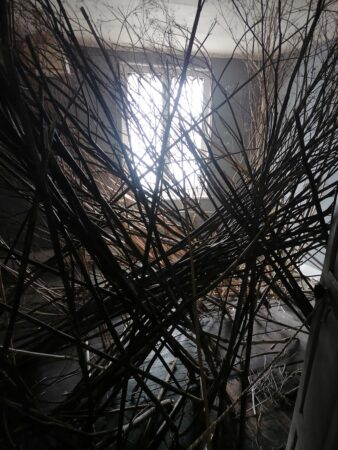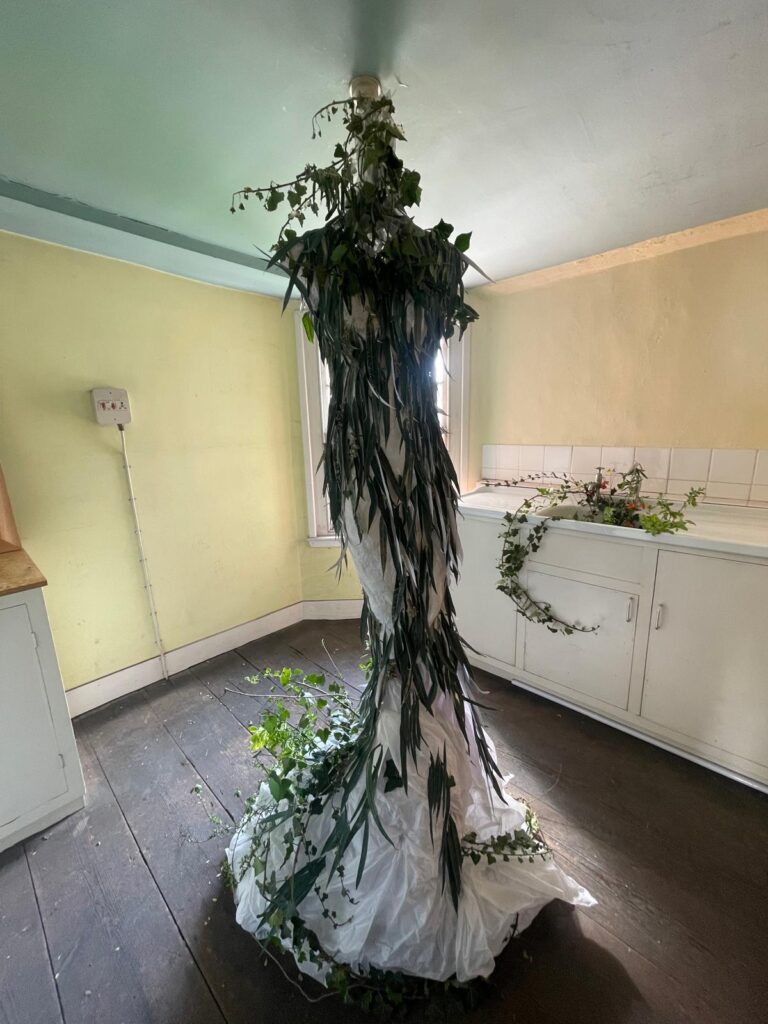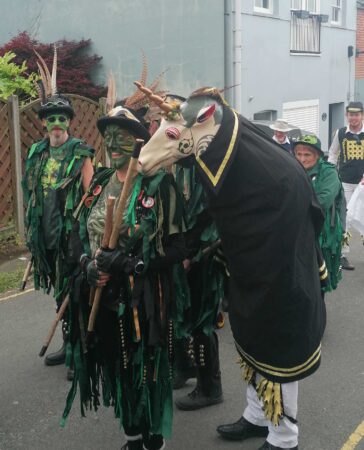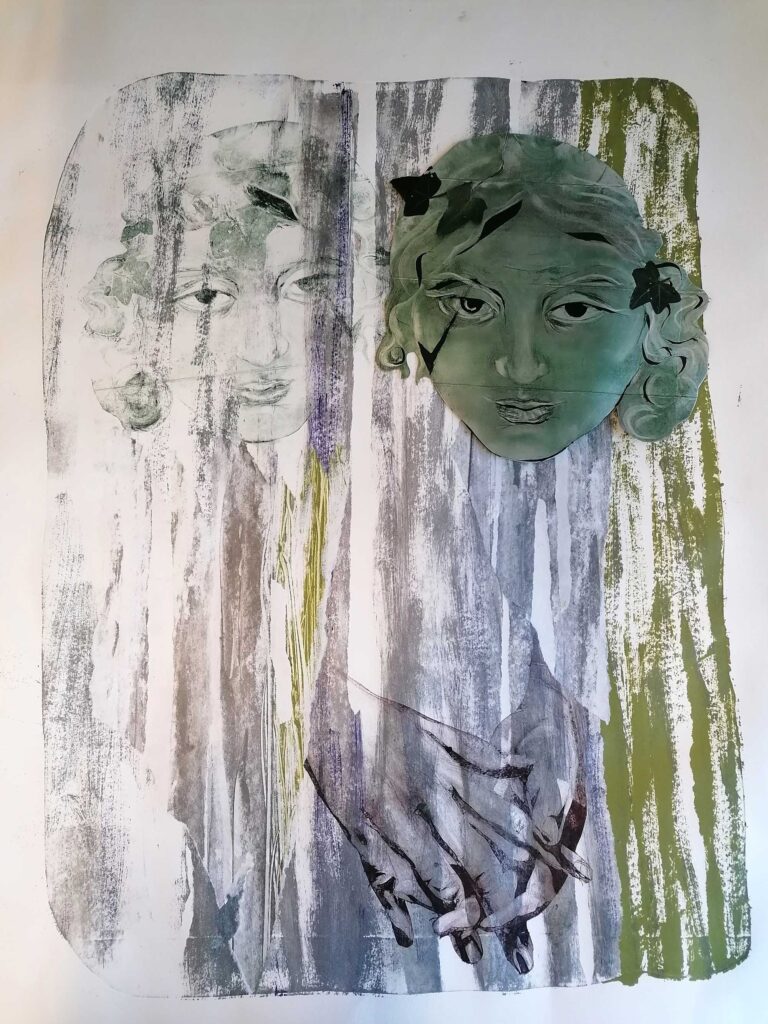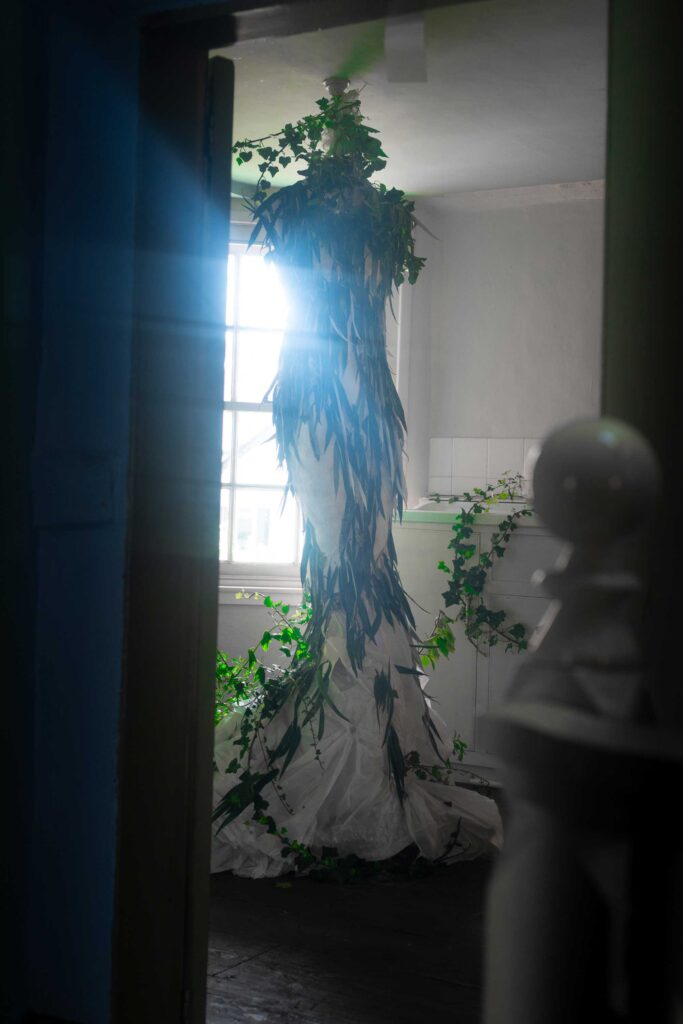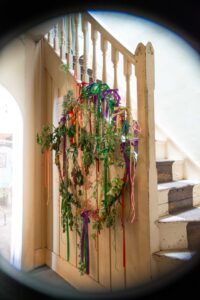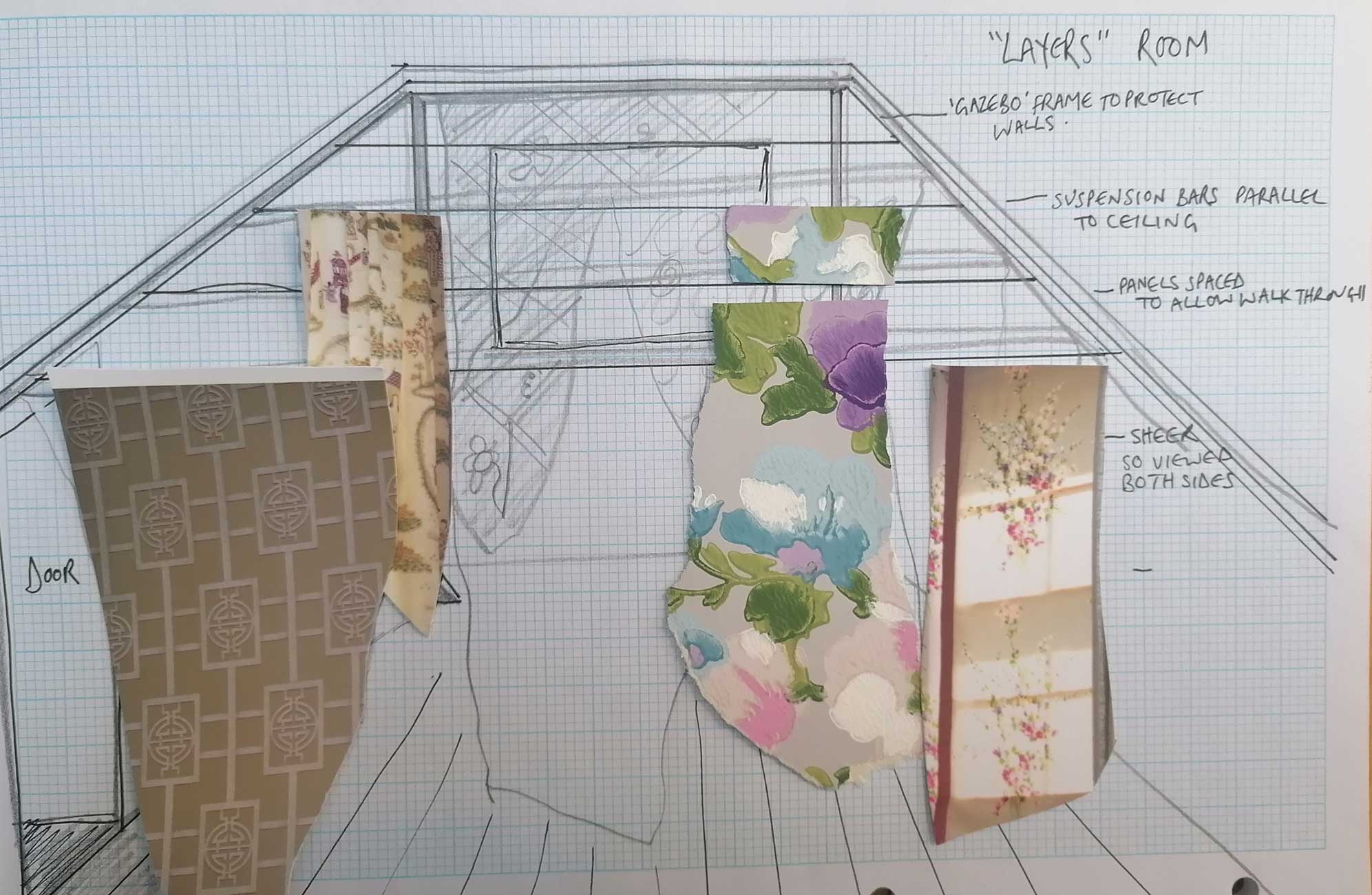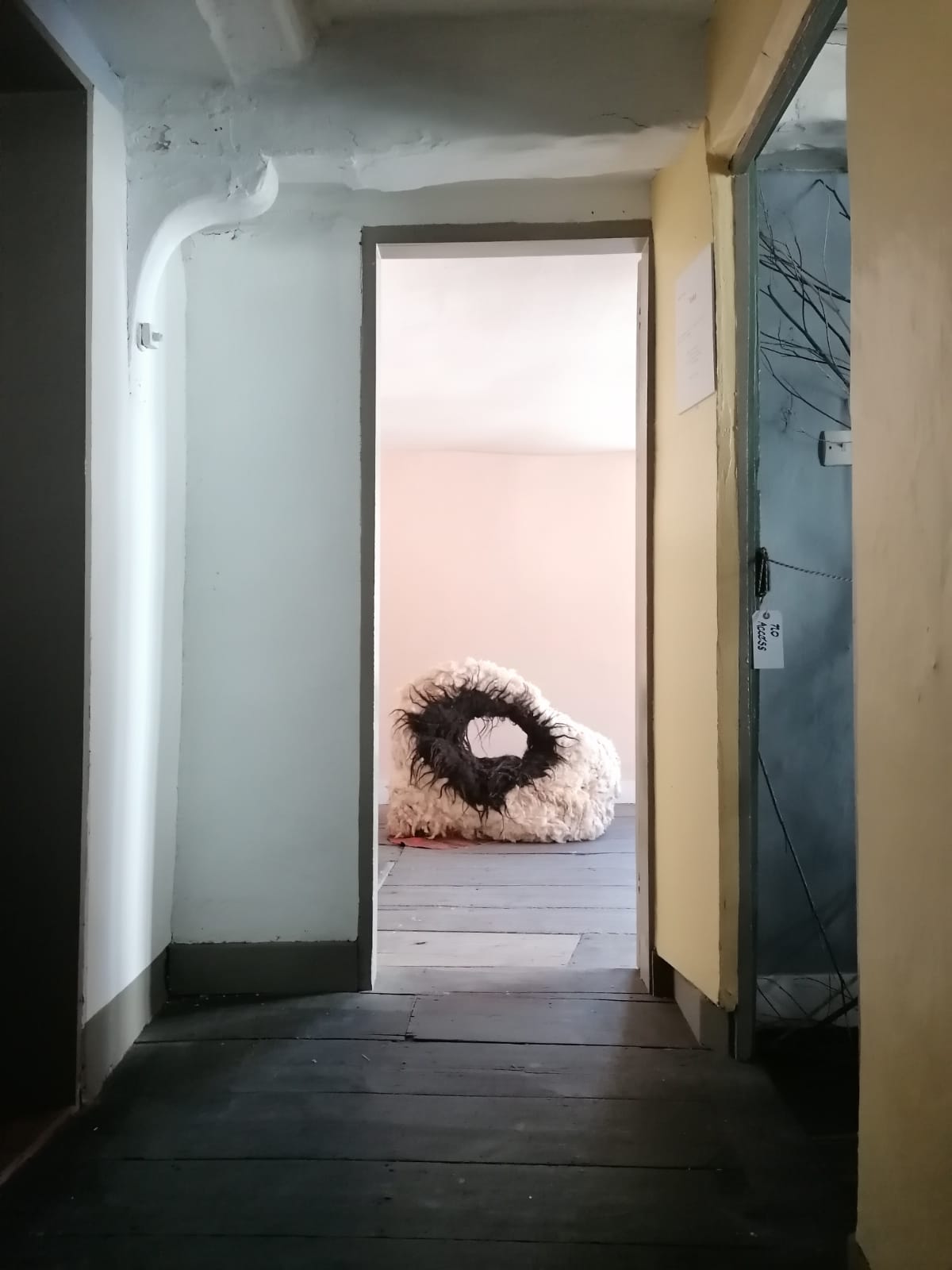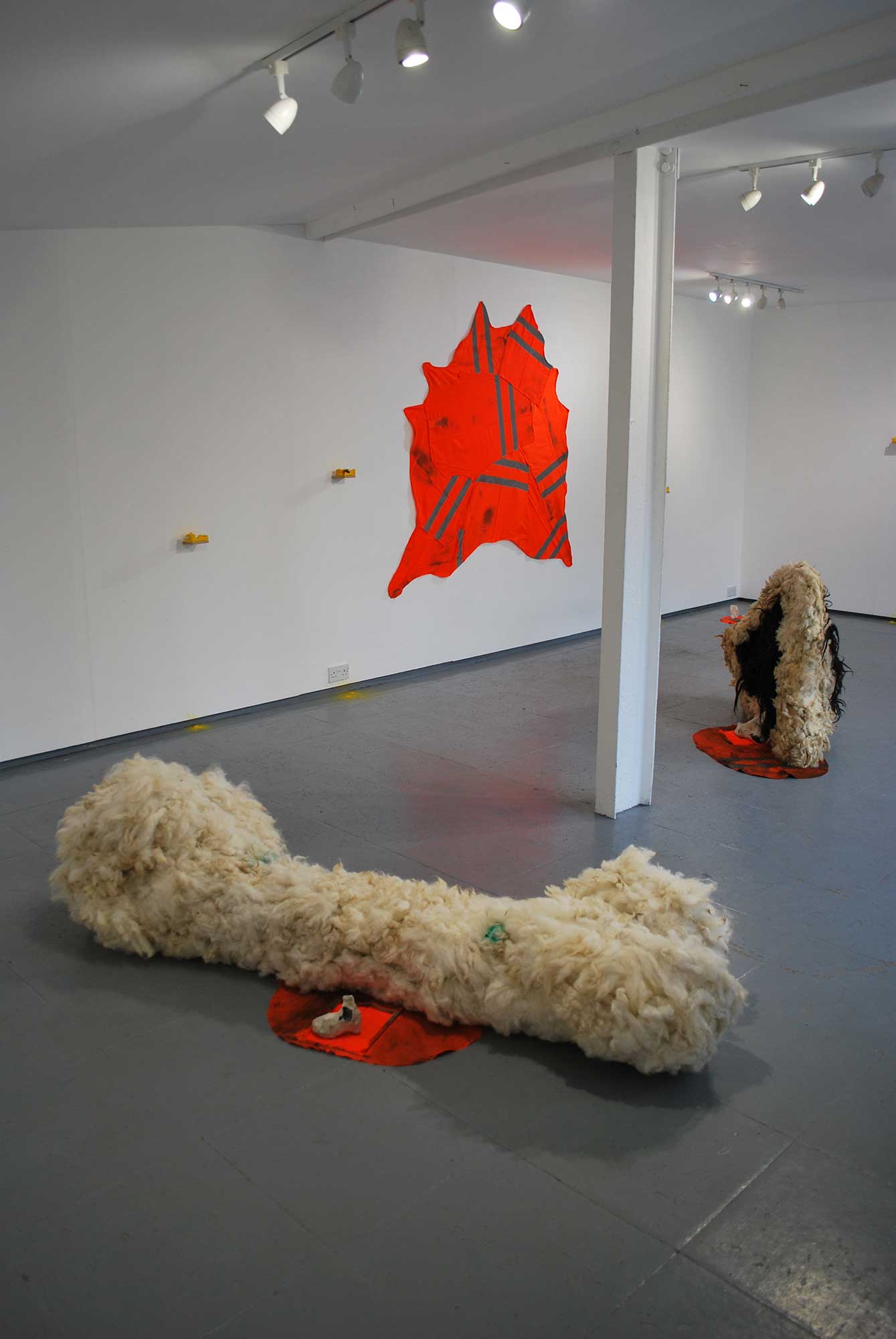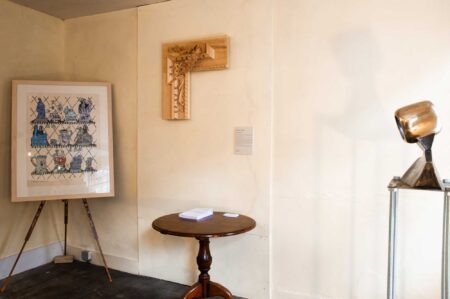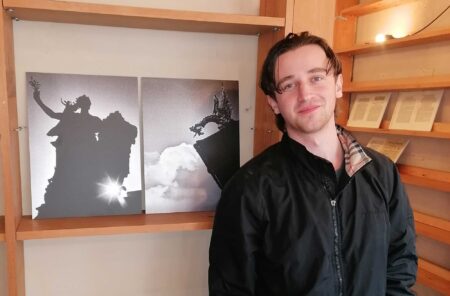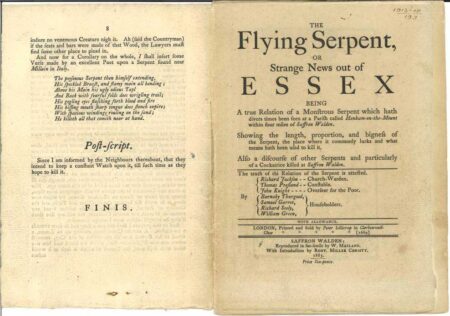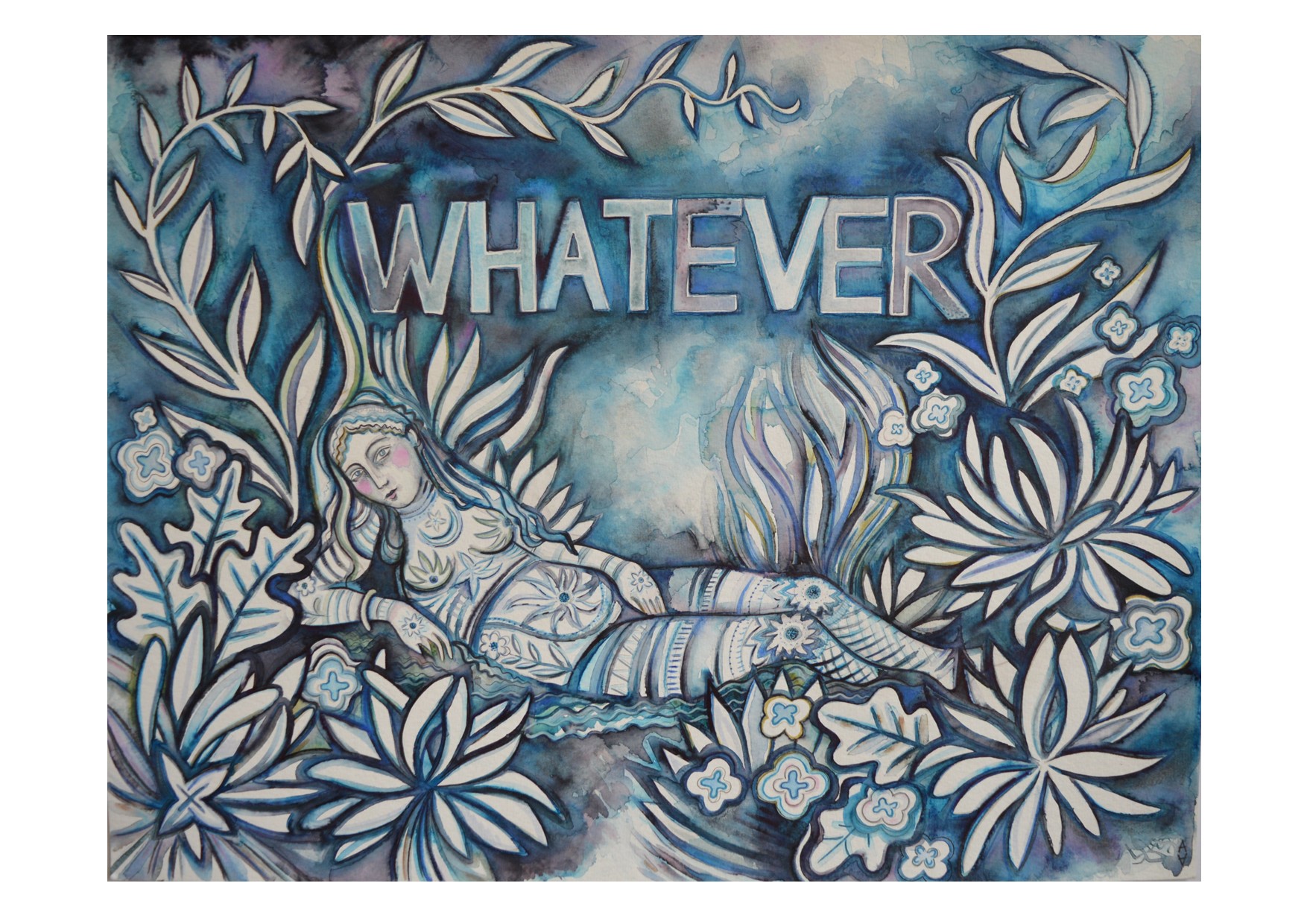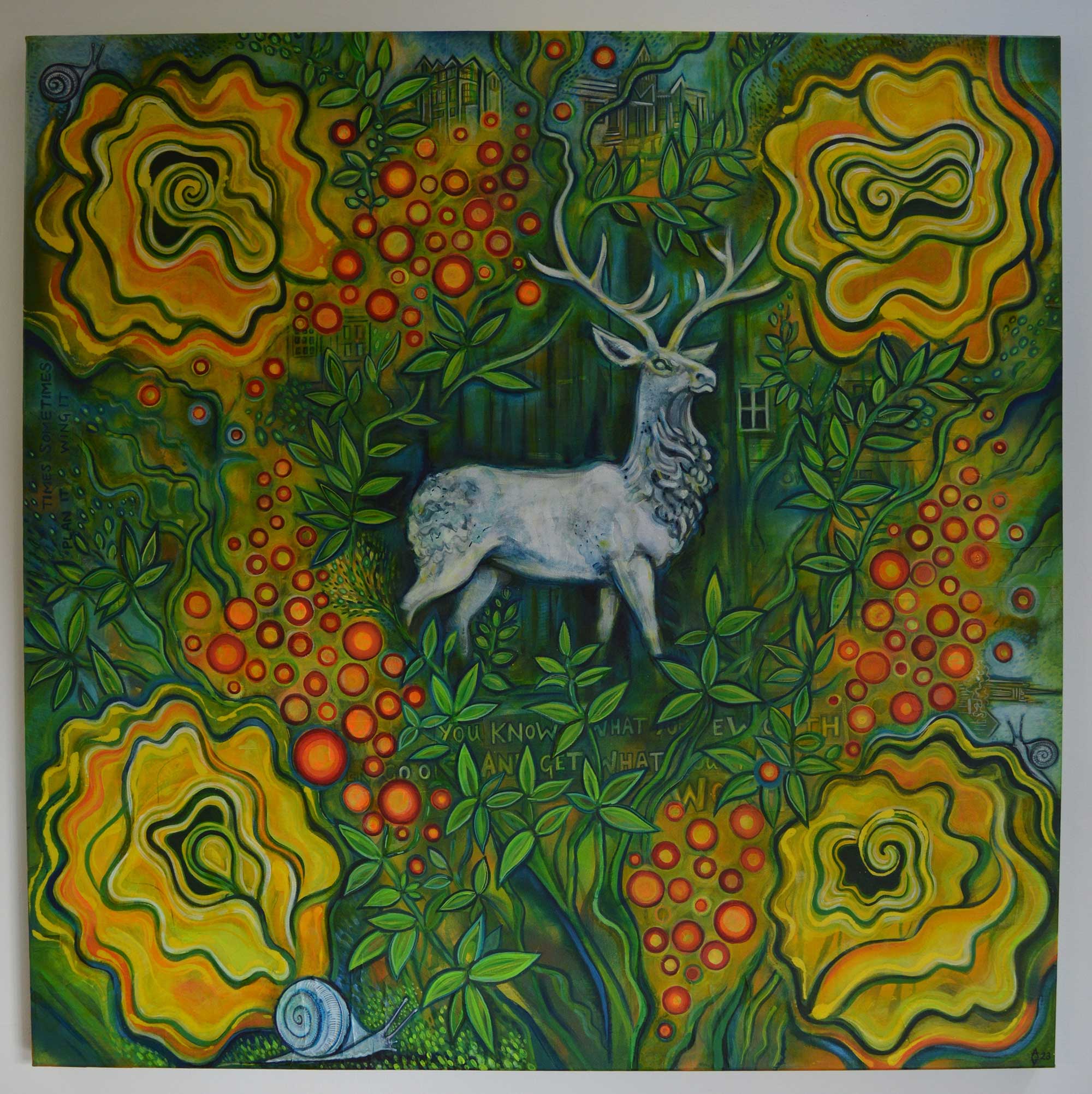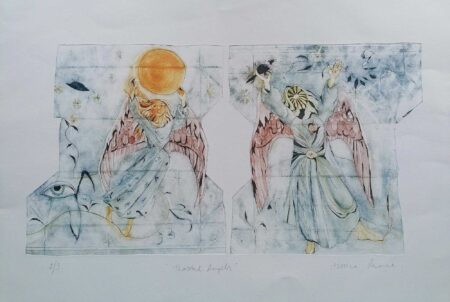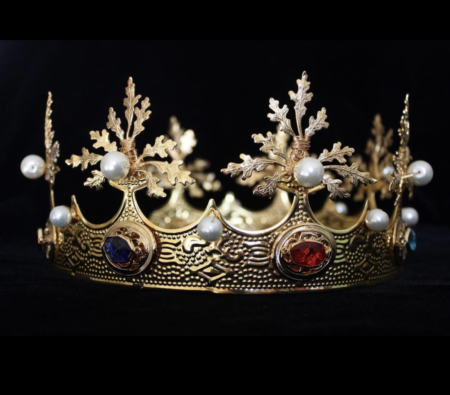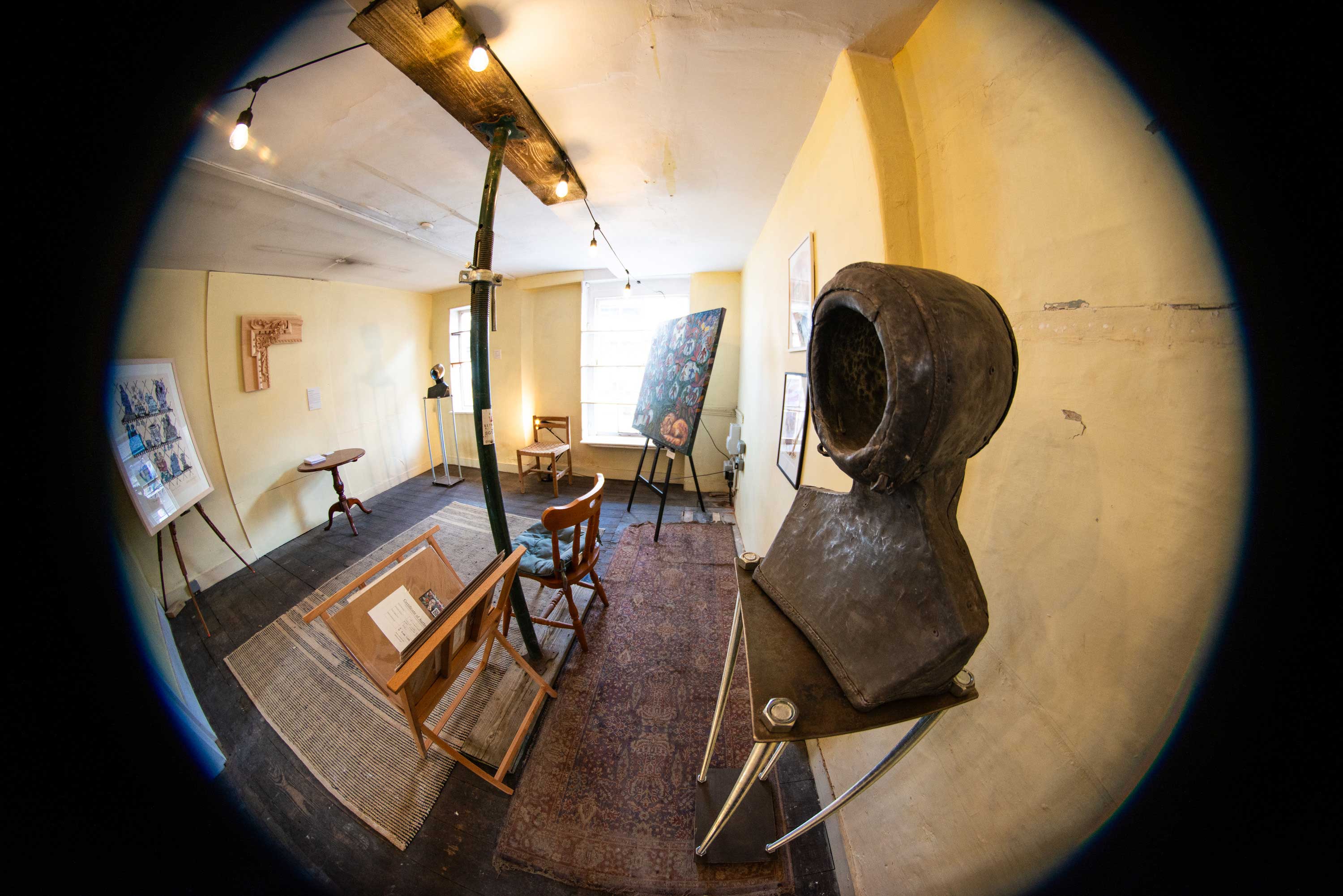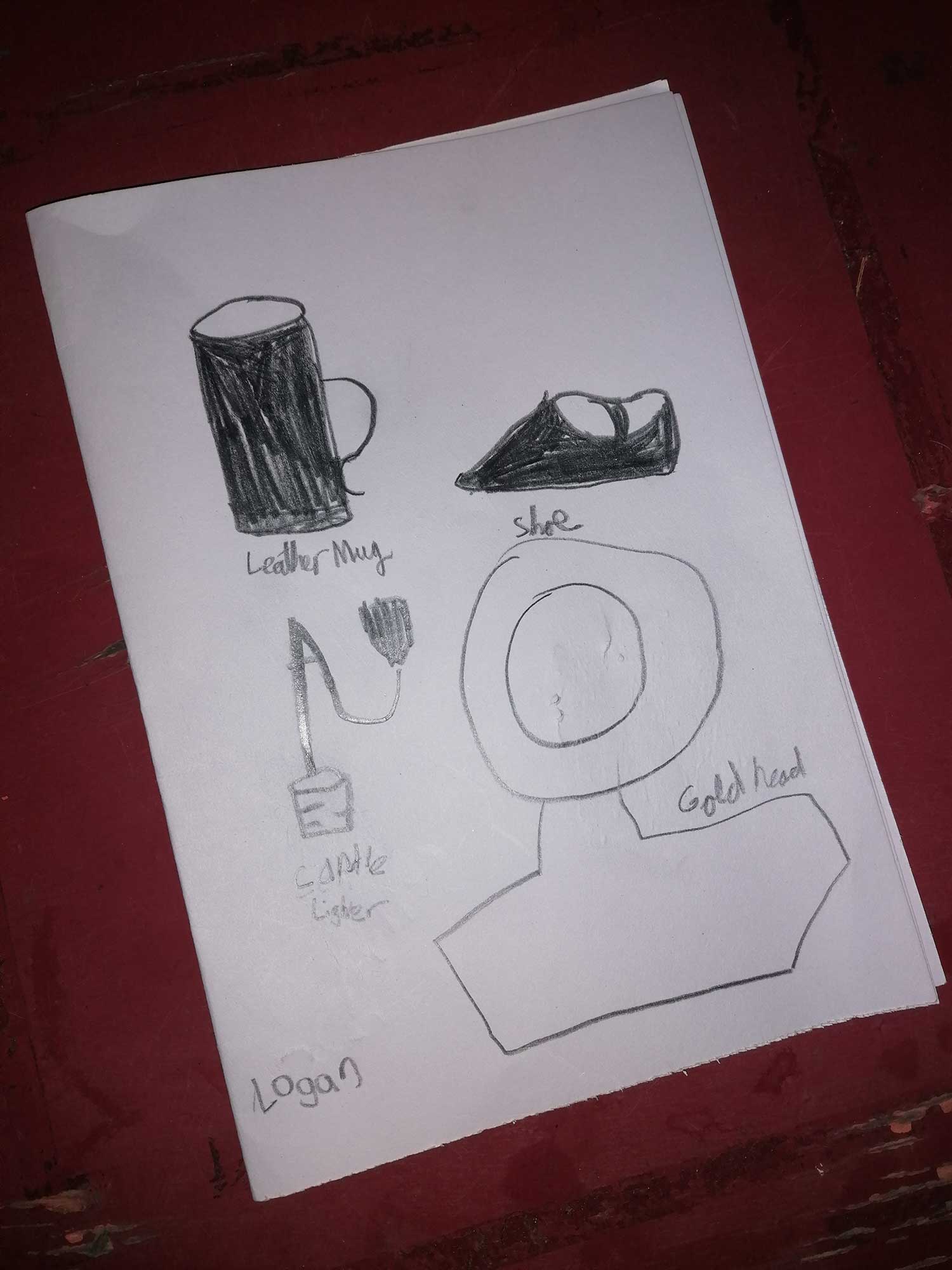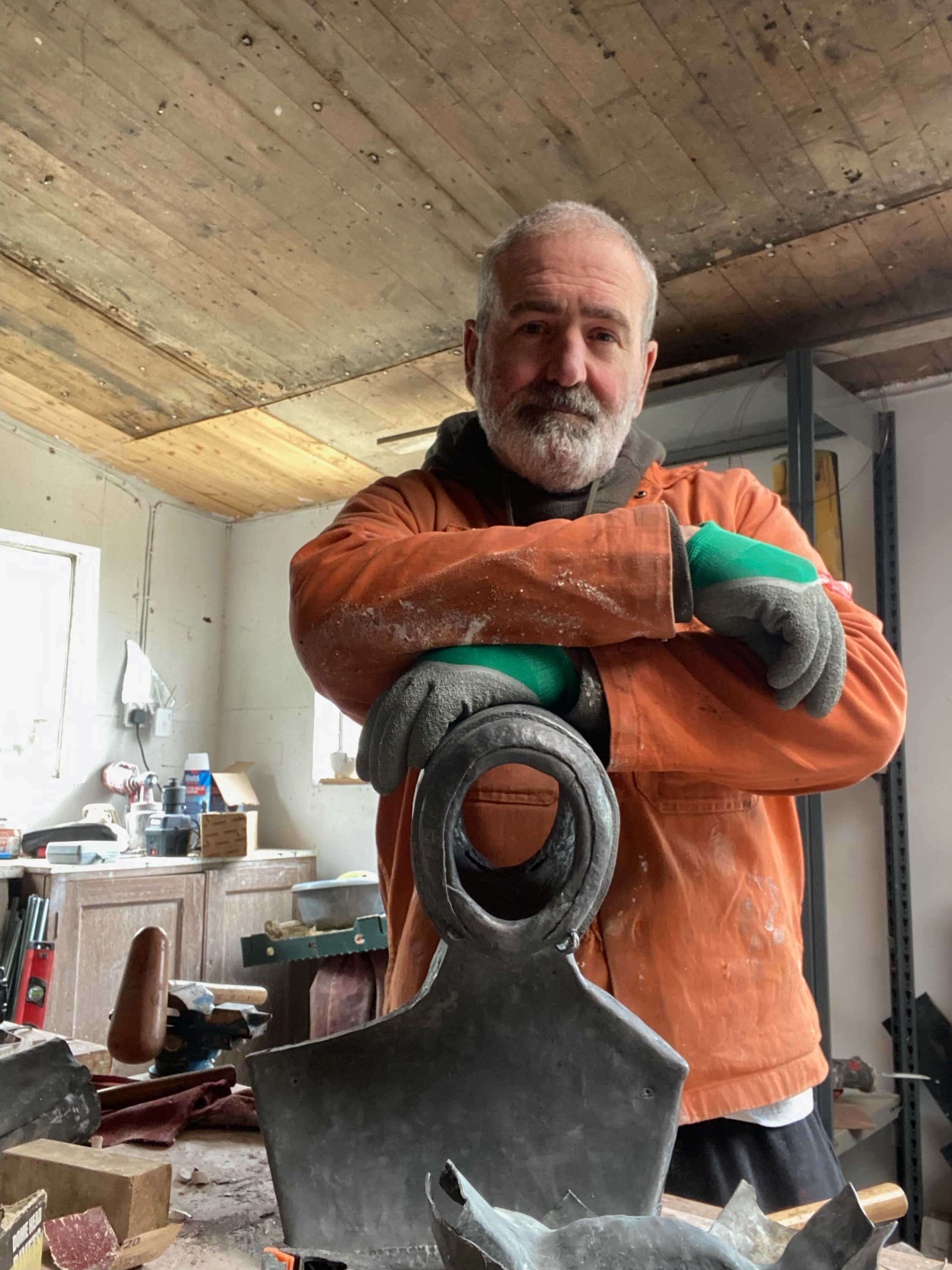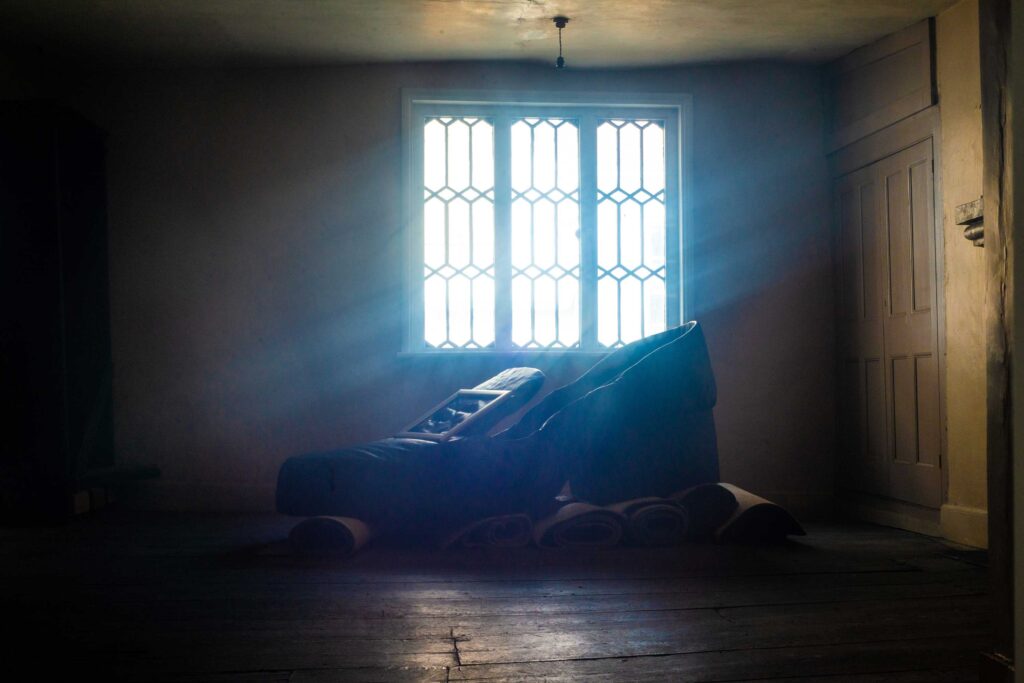
 I toured the Old Sun Inn last summer. It’s a stunning Grade 1 listed building that was medieval houses, an inn and in recent years a book shop called Lankasters. Dating of the original timber frame has revealed some trees was felled in 1347! This building is famous for being the former HQ of Oliver Cromwell and having the best examples of ornate figurative plasterwork (pargeting ) with the Wisbech giant of East Anglian folklore being fought by Tom Hickathrift. Wandering the rooms and cellars had my friends and I chatting timeslips, ghosts and musing who in history had trodden these same stairs.
I toured the Old Sun Inn last summer. It’s a stunning Grade 1 listed building that was medieval houses, an inn and in recent years a book shop called Lankasters. Dating of the original timber frame has revealed some trees was felled in 1347! This building is famous for being the former HQ of Oliver Cromwell and having the best examples of ornate figurative plasterwork (pargeting ) with the Wisbech giant of East Anglian folklore being fought by Tom Hickathrift. Wandering the rooms and cellars had my friends and I chatting timeslips, ghosts and musing who in history had trodden these same stairs.
I took lots of photos on the tour. Initially I made a print of the main stairway from one but looking at these photos over again I imagined wilder, immersive installations in the upstairs rooms. Eventually I plucked up the courage to approach the owner Douglas Kent with these ideas – and was thrilled he was supportive of the proposal, and opening up the Old Sun Inn for a free exhibition ! I shared my intrigue of the fragments of wallpaper in the building and was invited to view the archive of conserved fragments. This sparked the idea for ‘Layers’ ;creating a piece that showed the building’s history in literal layers was too good an opportunity to pass up!
‘There Be Giants’ became a gallery at street level for visitors to explore a curation of paintings, prints, sculpture and carvings inspired by local legends and folklore, including the Gog Magog giants, Essex Serpent, Humpty Dumpty, Morris Dancing and mythology. Upstairs was my artistic response to the atmosphere and history of the building.
Community Engagement
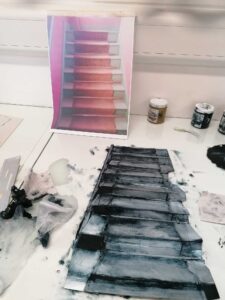 I’m honoured to be part of the Old Sun Inn’s new evolution as a hub for community events and resurrection of ancient crafts. In Covid children really missed out on engaging with the arts. I was able to invite school groups and homeschoolers to visit the exhibition and make brass rubbings, interact and sketch the exhibits and follow a brilliant specially created town art history trail created by the Saffron Walden Museum. On the weekends family groups did these activities together, and took the art trail challenge learning about the town’s 17th century past.
I’m honoured to be part of the Old Sun Inn’s new evolution as a hub for community events and resurrection of ancient crafts. In Covid children really missed out on engaging with the arts. I was able to invite school groups and homeschoolers to visit the exhibition and make brass rubbings, interact and sketch the exhibits and follow a brilliant specially created town art history trail created by the Saffron Walden Museum. On the weekends family groups did these activities together, and took the art trail challenge learning about the town’s 17th century past.
‘1647’
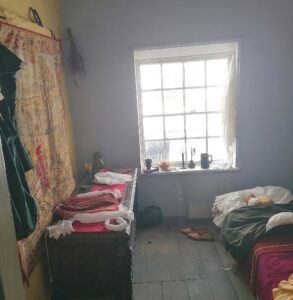 This room set imagines a family lodging at the Old Sun Inn in 1647 showing objects, furniture, clothes and domestic objects in common use during the era.
This room set imagines a family lodging at the Old Sun Inn in 1647 showing objects, furniture, clothes and domestic objects in common use during the era.
In May 1647, during the reign of King Charles I, Oliver Cromwell came to the Old Sun Inn with the parliamentarian New Model Army, making it his temporary headquarters. In two years time the King would be executed and Cromwell would become ‘Lord Protector of the Commonwealth’ a title he held until his death in 1658.
Creating a convincing ‘timeslip’ room set was made possible by Saffron Walden Museum whom I had sought advice on authentic looking 17th C artefacts. To my delight they loaned me a treasure trove of 17th C objects including plates, jug, clay pipes, coins, colostrel (leather water/beer containers) candlesticks, bone dice and authentic clothes; replica jerkin, ruffs, skirts and shoes. I borrowed tapestries and a carved trunk from friends and hung dried lavender and a clove orange for authentic smells! Luckily the view out of the window is a Tudor terrace, and once the owner Douglas Kent climbed up and removed an estate agent sign – the timeslip was activated!
I collaborated with Charlotte Pratt from Saffron Walden Museum who created a page on their website accessed via QR code so visitors could learn about history of each ancient object in the room. The ‘breathing’ cat asleep on the bed fooled quite a few visitors, he was named ‘Cromwell’ by a visiting group from St Mary’s Primary school!
To protect the delicate floorboards outside this room from the weight of groups Jonathan Bromley created a bespoke pallet step that allowed for a better view back in time!
The Market House bar next door created a special cocktail for the duration of ‘There Be Giants’ called 1647 Oliver Cromwell would definitely not have approved!
SHOE!
I designed this big leather pilgrim shoe to be like those worn in the pargeting on the front of the building and in the style of King Charles and Cromwell. It couldn’t look like a ‘prop’ – it had to be hobnailed, leather and look as if it was abandoned by a giant like Tom Hickathrift . This collaborative sculpture was cobbled together on my kitchen table using the upholstery talents of Aine Corr, master carving skills of Matthew Bateman, and construction skills of Jonathan Bromley. It lives in Saffron Walden Museum’s warehouse now. I’m hopeful the shoe will go on a history float at carnival time! I loved watching people double take as they explored upstairs and discovered it.
TIME
Local weeds collected from ditches in Saffron Walden and Great Chesterford, dried and stacked. My reflection on seasons and centuries. Of the installations, this elicited the most polarized opinions – some children came down and said it was an enchanted forest and wanted to curl up and sleep in there, another visitor expressed fear, and one man it made angry?! To me it was magical, expressing the charged emotions and wonder I felt being in a building that so many generations have lived and worked in.
I displayed this poem written by Robert Herrick in 1648 outside the room (which was next to ‘1647’):
‘Gather ye rose-buds while ye may,
Old Time is still a-flying;
And this same flower that smiles today
Tomorrow will be dying’
GREEN GODDESS
The inspiration for this piece is the folkloric tradition of the May Queen, she’s a feminized version of the Green Man diety and Jack in The Green. The Old Sun Inn had lain empty for many years after the bookshop closed and I wanted to revive the custom of decorating with greenery for May Day. I always feel sad when I see ancient headless sculptures, especially of women – so the head of this goddess is represented in the print at the back of the room (now at Church Street Gallery). I loved that there was a 60’s sink in the room and temporarily planted ivy and wild flowers in it that trailed out and joined up with the real foliage erupting from the tissue underskirts of the sculpture. I kept these alive with hidden troughs of water.
Originally I had come up with a complicated wooden tiered construction for the Goddess that was going to move, but I didn’t get any of the funding I’d applied for so I revised the design to use donated chicken wire to support the skirt and papier mach-ed my patient friend Johanna’s torso and legs in 3 separate sessions and then glued the pieces together. Hundreds of leaves were handprinted onto paper and hours spent cutting them all out, my wonderful neighbours Yvonne Chapman and Taegan Chapman Ko pitched in with this mammoth task. The Goddess was suspended from the ceiling light so she was backlit by sun coming in from the window. A guardian of nature heralding the brighter days of Spring and Summer.
- Inspiration
- Ideas
- Finished!
MAY POLE STAIRS
Reviving another ancient custom of welcoming the Summer and celebrating May Day/ Beltane by decorating with greenery! Originally I had the idea of a flower cloud for the same function, but there was no safe way to suspend it so we used the bannisters instead to suspend a hoop. Talented art student Miranda Francis created this beautiful display with greenery, ribbons and local flowers.
The maypole has its roots in ancient Rome and ancient Germany. It was not a Christian celebration, but a pagan one, celebrating the goddess Flora and the start of Summer. In the 17th century, maypole celebrations were banned because they were seen as being immoral in Christian societies.
The spring weather and maypole celebration are associated with fertility. Maypole dancing was described as ‘a heathenish vanity generally abused to superstition and wickedness’ and legislation was passed which saw the end of village maypoles made illegal by the Puritan parliament in 1644.
Dancing did not return to the village greens until the restoration of Charles II, and in 1661 a 134 foot maypole was set up in the Strand.
The custom of maypole dancing had a resurgance in Victorian times in England, mostly children rather than adults now did the dancing, and often wore pastel or white clothes decorated with flowers. White clothing is now often associated with this style of dance.
Maypole dancing is not just an English tradition, it still happens in Germany and Austria. Though not always held on 1 May, maypole celebrations also happen in the US, Malta, Scandinavia, Canada and Italy, with Italians using the pole to celebrate International Workers Day.
LAYERS
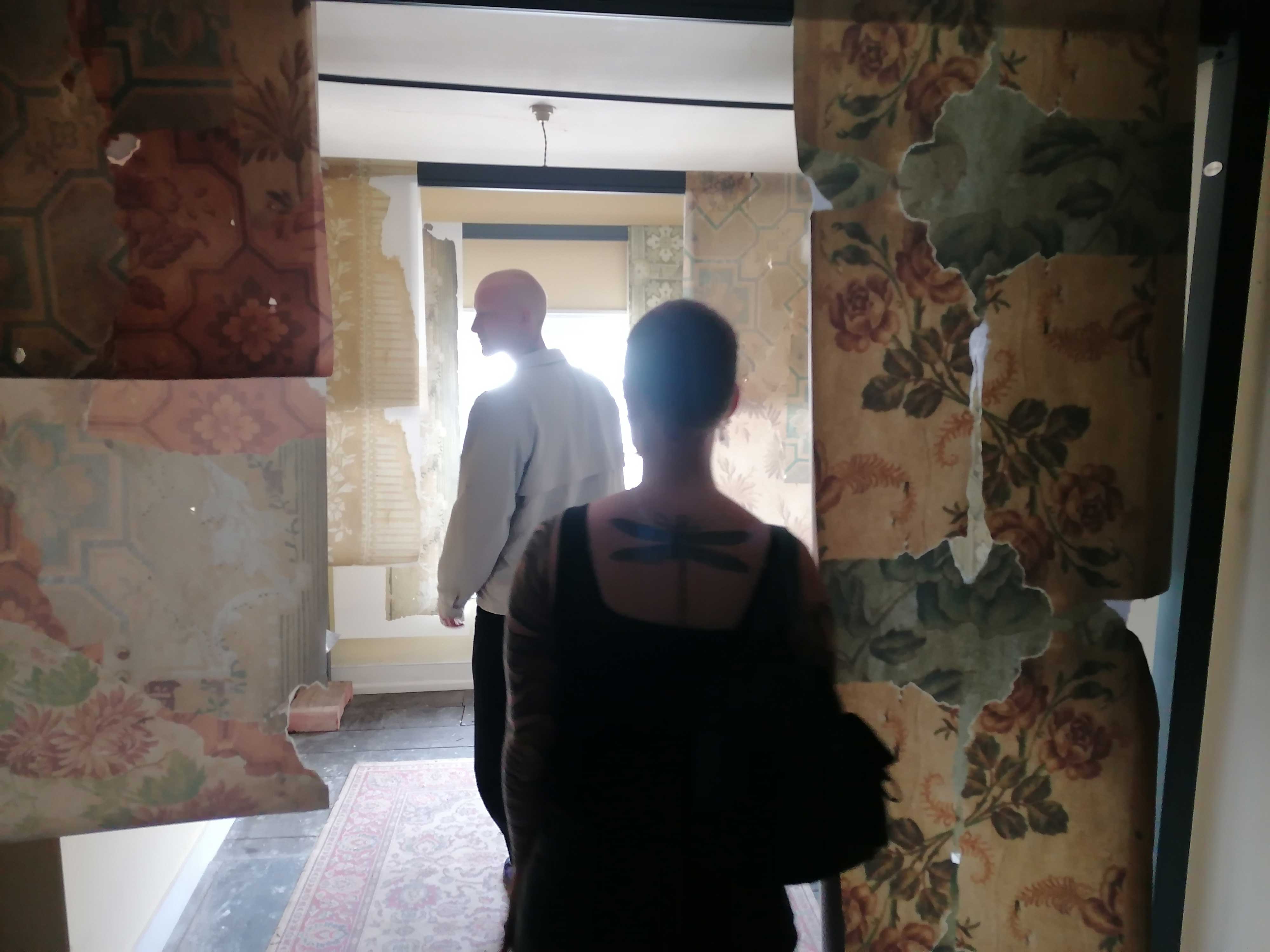 Layers: Wallpaper strips digitally printed on hemp and mulberry paper depicted the building’s decorative history.
Layers: Wallpaper strips digitally printed on hemp and mulberry paper depicted the building’s decorative history.
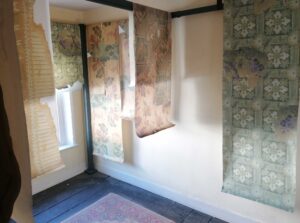
These strips, supported by gazebo frames, showed layers of wallpaper found in different rooms, offering a glimpse into patterns of the past.The strips are composites of the archived scraps found on top of each other in different rooms – in some places up to 26 layers deep! These papers have been dated from the 1800’s to the 1950’s. Underneath them are layers of paint and varnishes which have been scanned and analysed that resemble geological samples. 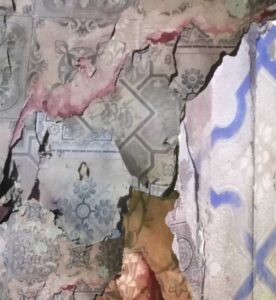 This peek into the successive design choices in the Old Sun Inn was the favourite installation of many visitors. Quite magically underneath the paint in this room are medieval wall paintings in this room waiting to be uncovered.
This peek into the successive design choices in the Old Sun Inn was the favourite installation of many visitors. Quite magically underneath the paint in this room are medieval wall paintings in this room waiting to be uncovered.
A big thank you to Tim Houghton whose digital skills helped me translate the wallpaper pattern fragments into strips signifying the successive layers in each room.
Here’s my original sketch.
If Walls could Talk – Scribed Circles
On the reverse of the wallpaper lengths, I inscribed circular and hexafoil patterns –representing the apotropaic symbols carved into the stone and timber of ancient buildings like the Old Sun Inn. Also commonly called a daisy wheel, a hexafoil shape has several symbolic interpretations; it was believed to ward off witches and evil spirits. Hexafoils were often placed near kitchens or other food preparation areas for protection, and door ways and chimneys where evil was thought to enter.
These circles and multifoil circles were scribed by masons, frame carpenters and plasterers with compasses and were particularly prolific in the superstitious 17th century.
The function of the circle is, and was, a geometrical shorthand for design – the daisy wheel pattern is a geometric source of precision 30°, 60° and 90° angles (with further angles constructed by halving or addition) – the same angles provided in a frame carpenter’s square.
The daisy geometric pattern is sometimes known as the Genesis pattern and dates back to the late Bronze Age. The ‘flower of life’ was considered perfectly formed of equal proportion and harmonious, and thought to be a form of divine enlightenment, and used as a circle to contain or create. It was known throughout the world to stonemasons, architects, philosophers, alchemists, occultists and artists. The Jewish Kabbalistic tree and its mysticism is also thought to be derived from the flower of life. Interestingly it is also the shape made by the planet Venus as viewed from Earth, and was called the flower of Aphrodite (Venus and Aphrodite being essentially the same goddess).
The wheel is an ancient Solar symbol that has been identified from Egyptian tombs and prehistoric ritual sites in Europe. My foil card print ‘Tomb’ downstairs depicts one of these scribed circles. These geometric symbols were cut with a pair of compasses and sometimes contain three petals indicating the Trinity. Others have six or 12 petals but all are thought to be protective, acting as ‘demon traps’ to capture, confuse or deflect evil spirits. Examples have been found on the roof timbers of barns and walls of churches dating from the medieval period until as recently as the 19th century. Some appear to have been cut in fresh wood before it was incorporated into buildings while others were made once the timber had dried out. Examples include those at Shakespeare’s birthplace, where they are carved near the door to a cellar once used to store beer.
Also found in the Old Sun Inn are deliberate scorch marks in the wood – these were made as a protection against fire. Holy Candles blessed by a priest on Candlemas were thought to have specific power over thunder, lightning and devils and were taken home after services. Deliberate burn marks in buildings made with these candles were believed to be protective. Sometimes these burn marks become known as ‘claw marks of the Hell hound’. In reality the marks were originally created to ward such beasts away! As is often the case in folklore, a story emerged to explain their presence long after their original purpose had been forgotten.
GOGMAGOG – by Caroline Bugby
‘GogMagog’ was first exhibited as part of Caroline’s solo show at Cambridge Artworks in January 2024, I was thrilled she agreed to be a part of this show. In English folklore Gogmagog was the last of the giants. At Wandlebury, large chalk hill figures have been partially excavated. Whether they were made by Bronze Age people or natural phenomena during the ice age is uncertain.
The Gog Magog Hills of Cambridge functioned as a starting point for the sculptures with geology, archaeology and their intersections with mythology and folklore forming the basis of these works made from wool, willow, recycled hi-vis material, flint.
In areas around the world where giant tales were woven into local mythology, often the fossilised bones of mammoths had been found and identified as the skeletons of enormous humans. @carolinebugby carolinebugby.co.uk
The Gallery
This my first exhibition curation, which turned out to be a joyous community collaboration. I couldn’t have done without the assistance, time and talents of artist Aine Corr (ainecorr.art) whose fantastical, detailed paintings of medieval figures and animals interwoven with local myth convinced me there needed to be a whole exhibition drawing on those very themes.
The installation had some challenges, as there were only agreed wall spaces we could use to hang works using special removable command strips. Elsewhere we used easels, existing bookshelves and cabinet surfaces to display the work. Delicate plasterwork or flooring was protected and the extensive cleaning done before we could install anything was done solely with a damp cloth and plain water.
I interspersed excepts of ancient texts from Saffron Musuem’s archives that reported on the Essex Serpent and Henham dragon with Michelle Thompson’s (michelle-thompson.com)
Aine Corr’s 17 fantastical, detailed paintings depicted her vision of the siege of Colchester, Boudicca, and Humpty Dumpty ( a cannon in reality) parachuting to safety instead of smashing to smithereens. ‘I have a Big Familiar’ depicted a persecuted witch from the disturbing Essex witch trials of the 17th Century riding the 1980’s He Man Battle Cat to battle. I particularly loved this piece – a good example of her signature mix of historical and personal narratives. She also painted the Henham Dragon with a backdrop of trees from her favourite local lake Gosfield. Her fascination with myth v reality and her extensive knowledge of local folklore and legend was a big driver in my wanting to put together ‘There Be Giants’.
 Of my own print work I showed these folklore and local history inspired prints made at the Curwen Print Study Centre; ‘Cromwell’s Stairs’, ‘Thaxted Angels’ and ‘Horndance’ – the latter based on the Abbots Bromley Horndance in Thaxted that originates from the`12th Century and is still performed by Thaxted Morris Dancers today.
Of my own print work I showed these folklore and local history inspired prints made at the Curwen Print Study Centre; ‘Cromwell’s Stairs’, ‘Thaxted Angels’ and ‘Horndance’ – the latter based on the Abbots Bromley Horndance in Thaxted that originates from the`12th Century and is still performed by Thaxted Morris Dancers today.
Boudicca‘s Serpent Crown by ‘Mr Mortimer‘s Wife’
This crown is designer Samantha Walden’s love letter to a childhood spent poring over books of local folklore. Inspired by the mythology of Boudicca, Queen of the Iceni and tales of the enigmatic Essex Serpent, this crown embodies the essence of centuries old tales woven into the fabric of local history.
@mrmortimerswife
Matt Bateman and Greg Meeson (Refinery Works)
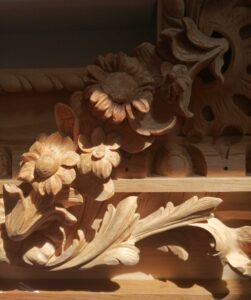 This intricate flora and fauna carving of a heritage overmantel formed part of their ongoing work at Stowe House. They have pioneered new techniques combining digital scanning tech with highly skilled traditional hand carving that are pure artistry !
This intricate flora and fauna carving of a heritage overmantel formed part of their ongoing work at Stowe House. They have pioneered new techniques combining digital scanning tech with highly skilled traditional hand carving that are pure artistry !
Matt used his joinery mastery to create the perfect heel on the shoe sculpture – I can reveal this has a secret chamber with a time capsule message inside it!
@workshop_bateman @refinery_works
refinerystudio.co.uk
Olivia Richardson
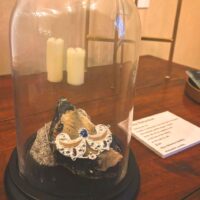 ‘Reviving the Sun‘ Necklace in sterling silver, brass, blue lapis & red garnets.
‘Reviving the Sun‘ Necklace in sterling silver, brass, blue lapis & red garnets.
Olivia’s unique handmade jewellery design is inspired by the Old Sun Inn pargetting motif on the front of the Old Sun Inn.
Richard Oliver, sculptor, is a prominent member of Butley Mills Studios Foundry in Suffolk who casts professionally for other artists and has a background in sheet metal work. The enigmatic bronze and lead ‘Hollow Heads’ had a such a powerful presence – in this space they conjured associations with armour and iconography.
@richardoliver.official
As a community, we came together to create something truly special, transforming the Old Sun Inn into a beacon of creativity and history. I’m very grateful to Douglas Kent and his business partner James for allowing access to their stunning building for this project, and for the support of Saffron Walden Museum, in sharing their archive texts and 7th century treasures.
For helping me clean decades of dust from floors and shelves before the installation and transport so many wierd things in and out of a medieval building had it’s challenges. Richard Oliver, Jonathan Bromley, Kelly, Henri, Sophie and Kirsti – you are amazing THANK YOU!
